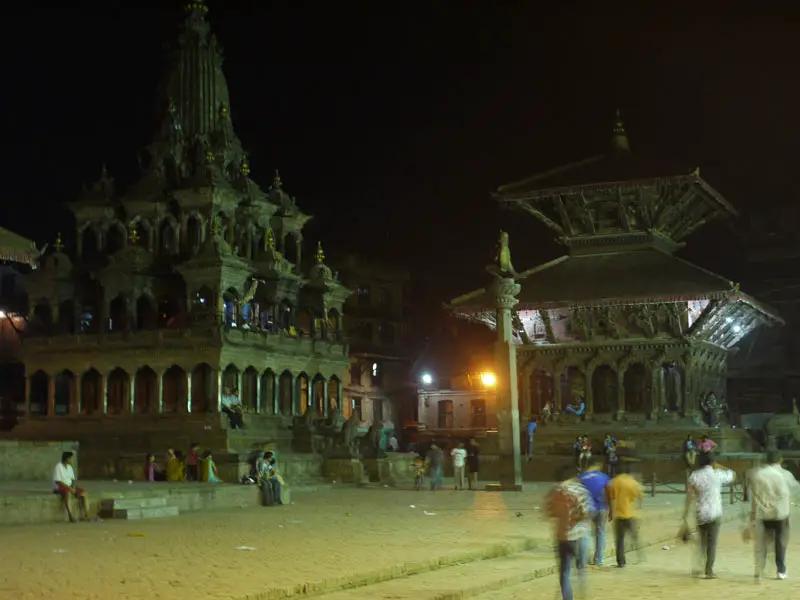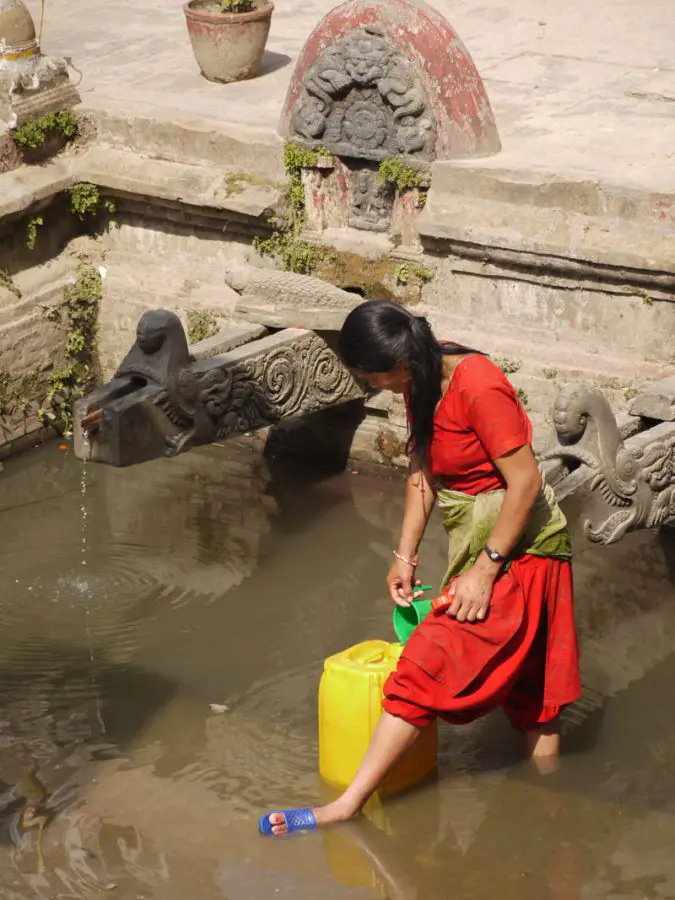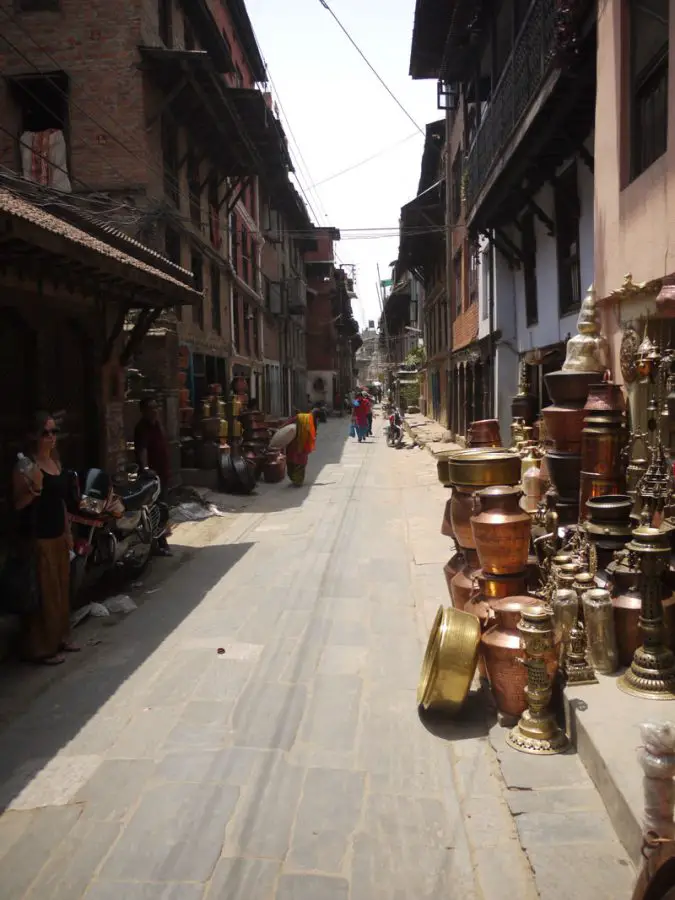Having already visited Kathmandu’s Durbar Square and Bhaktaur’s Durbar square, we completed our trio of medieval city-states in the Kathmandu Valley with a trip to the Durbar Square Patan. Patan is now a more upmarket suburb of Kathmandu, home to fancy restaurants and the area in which most expats living in Nepal have based themselves. This modern suburb was once a powerful independent city state and hosts the Durbar Square Patan, containing an amazing collection of immense temples both within the square and in the surrounding area.
The roads around Nepal were yet again deserted due to the ongoing strikes over the possible changes to the constitution. With no taxis or buses running we had two options; walk two hours across the city in the thirty degree heat or be lazy and take a rickshaw…rikshaw it was. The rickshaw ride to Patan took forty minutes in the midday sun and on arriving we walked through Patan Dhoka, the old white-washed city gate. We continued on through the maze of narrow back alleys, asking for directions to Durbar Square Patan as we went. Finally, we walked into the square from the north end and before us was the famed collection of ancient, Newari temples.
To our immediate left was Manga Hitti, a sunken area of the square where locals collect water from three beautiful carved stone spouts. Directly across from the water conduit was the three-tiered pagoda style Bhimsen temple, dedicated to the god of business and trade, currently undergoing renovations. Beside the Bhimsen temple is another wooden pagoda style temple, this time only two tiered. This, the Vishwanath temple, is dedicated o Shiva and is guarded by two huge stone elephants on the eastern side, while on the western side sits Shiva’s mount Nandi the bull, ready to take Shiva where he needs to go. Wandering on through the square, the hugely impressive stone temple of Krishna Mandir, in the Northern Indian style, grabs your attention more than the rest. The details in the carvings surrounding the three tiers is stunning and while only Hindus can enter, the chanting and music that comes floating from the temple in the evening is for everyone to hear. Two large stone columns stand in the square each approximately twenty feet high. On one sits a Garuda (half man, half bird) and on the other sits a brass statue of King Yoganarandra Malla’s statue, who conquered Patan in 1597, uniting the valley. Walking towards the northern end of the square we were treated to more wooden pagoda style temples and one more fine stone Krishna temple before passing the giant Taleju Bell, used by the people of the time to alert the king of their grievances. The entire eastern edge of the square is occupied by the Royal Palace of Patan. The red-brick, three-story building is striped with lines of ornate mahogany windows which look onto the square outside and the courtyards within he palace grounds. We left the palace, now home to a museum, behind us planning to visit tomorrow and went in search of somewhere to stay.
Due to the strike, all the shops and other businesses were closed until 5pm and the cobbled streets of Patan were very quiet. We had to knock on the locked guesthouse doors to gain access but we got a room without any problems. The advantage to the strike for us was that we had a rare opportunity to see the old city with no traffic as we imagined it may have been like centuries ago. As well as this, we got to see it for much less money than most tourists because there was nobody manning the ticket desks at any of the temples around the city.
We spent some time venturing into small courtyards and venturing down narrow side streets looking at shrines and temples galore. A twenty-minute walk took us to the expat area of Pulchowk for a somewhat fancier than usual dinner before returning to watch Durbar Square Patan really come into it’s own after the sun had gone down. We stayed a while in the packed square, the illuminated temples creating a unique backdrop to the busy night-time scene.
The following day brought the usual noise and traffic, the strike was over for now. The museum in the Royal Palace was to be our first stop. A few hours passed by as we worked our way through the exhibits. Finally, we emerge and felt we had a better understanding of some of the Hindu and Buddhist gods and their stories. The museum had been well worth the visit. After a quick lunch we embarked on the Patan walking tour starting at the city gate to the north. We followed our map through the city, getting lost a few times but the number of monuments, temples and shrines that filled the cities back streets was extraordinary. It was pitch black as we reached the Golden Temple where people were chanting and singing by candlelight. The hugely impressive five tiered Kumbeshwar temple was our last stop on our tour and we sat and watched as people came and went lighting butter lamps and praying to Shiva and Parvati.
The highlight of our trip to Patan came as a surprise. This morning was our last morning here and we left the guesthouse on a different walking tour of the temples in the southwest of Patan. Once again we found some stunning temples in the back alleys and courtyards but the real surprise came at the final stop. We walked into the courtyard of the Haka Bahal temple, which is linked with Patan’s Kumari cult religion. The Kumari Devi is a living goddess whom devotees worship. The goddess is always a young girl and she goes through a rigorous process to be ordained as the Kumari Devi. Usually the chosen girl is between four years old and puberty. She is chosen based on satisfying thirty-two physical characteristics such as eye colour, the shape of her teeth and the sound of her voice. The candidates are put in a dark room where men in masks dance around making terrifying noises to the backdrop of one hundred and eight buffalo heads. The goddess is the candidate who remains calm throughout the entire initiation and becomes the new Kumari. Once chosen, she and her family move into the temple, rent free! She stays until the end of her reign, marked by her first period or any serious accidental loss of blood. The Kumari is supported by the temple income throughout her reign and on retirement she’s paid a generous dowry, not a bad deal by any standards.
At the gate of the temple a group of Indian tourists were waiting to meet their goddess. They had come specially for this great honour and so we too went up the rickety stairs inside the temple and sat cross-legged waiting to meet a living god. A few minutes passed and she passed through the room to the one beyond. The small gathering of devotees stared as she passed and in hushed tones they formed a line outside the door, eagerly waiting meeting their ten-year old goddess. We watched through the doors as people went through and made offerings of money to the young Kumari. They kneeled before her one by one and touched her feet. Next it was our turn. Nervously, not really knowing what was expected of us, we entered the room. We awkwardly knelt down before the goddess. She sat in a silk red robe on a small throne with long streaks of black makeup around her eyes. Around her neck hung large silver necklaces and she held herself with an air of regality. We bowed to her, feeling a bit odd and we were even allowed a photo before our time was up. We left the room and then the temple, feeling like we had met a celebrity. We may not have had the same appreciation for our encounter with the Kumari as the Indian devotees we had met but nobody could take away from us that we had just met a living goddess, that’s certainly a first!

Brian is a travel writer, photographer, blogger, travel addict and adventure-junkie. Being outdoors, getting off the beaten track and outside his comfort zone is what makes him tick. Brian’s the dreamer in the relationship; when he’s not travelling, he’s dreaming about it! Keeping fit, cooking, music and red wine take up the rest of his time.
Sign up for our free travel photography Ebook "Faces of Nepal" and you'll also receive our monthly newsletter.









First I’ve heard of the Kumari Devi and a very weird initiation practice aswell haha. Unique viewpoint on Nepal!
Hi Wibi. We found it very interesting – love finding things like this when we travel 🙂